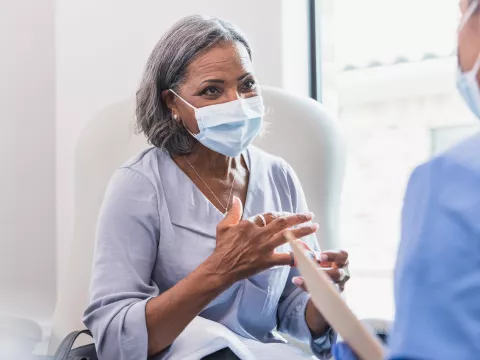- AdventHealth

Some things are just easier to talk about with your sister or closest girlfriend. Sensitive health problems, from vaginal issues to hemorrhoids, may fall into this category.
If you feel a bit shy about bringing up these subjects with your doctor, that’s normal. But do it anyway. Remember that talking about such things is all in a day’s work for your doctor. And they’re trained and experienced to communicate with respect and empathy.
Often, your symptoms may be caused by a condition that could be eased or cured by a treatment.
Here are four common health issues you should discuss with your doctor (even if you’d rather not).
-
Vaginal Discharge
It’s normal to have some clear to white vaginal discharge. But let your doctor know if you notice a change in the color, amount or consistency.
One possible cause is a yeast infection, which is caused by a fungus and may lead to a cottage cheese-like discharge, along with genital itching and burning. Nearly three-fourths of all women will have a yeast infection at some point. If that’s the source of your problem, it can be treated with antifungal medication.
Other genital infections can lead to similar symptoms, however. The only way to know for sure what you’re dealing with is to see your doctor.
2. Genital Odor
A certain amount of vaginal odor is to be expected. But tell your doctor if you notice an odor that’s strong or different from usual. You could have a vaginal infection, and trying to cover up the smell by douching may only make things worse.
Bacterial vaginosis (BV) is the most common vaginal infection in women younger than 45. It may cause a “fishy” odor, along with increased vaginal discharge and a burning sensation when urinating.
Several other infections can resemble BV, so don’t try to self-diagnose. If it turns out that you have BV, your doctor can prescribe an antibiotic.
3. Painful Urination
Another possible cause of pain or stinging during urination is a urinary tract infection (UTI). If you have a UTI, you may feel a strong, frequent urge to urinate or pressure in your lower belly. Your urine may smell bad or look milky, cloudy or blood-tinged.
If you see blood in your urine, tell your doctor immediately. Although it may just be due to a UTI, it could have other, more serious causes.
A UTI can be treated with antibiotics. Getting treatment is important, because an untreated infection may damage your kidneys.
4. Hemorrhoids
Hemorrhoids — swollen veins in the anus or lower rectum area — are common in pregnant women. If you have hemorrhoids, you may see bright red blood in your stool or on toilet paper after a bowel movement. You may also feel anal itching or discomfort, and sometimes the vein may even bulge out.
Get your symptoms evaluated by a doctor. Other conditions, including cancer, can also cause blood in your stool.
Hemorrhoids can often be relieved by simple lifestyle measures, such as eating more fiber. But if that isn’t enough, your doctor may perform a procedure to shrink the swollen tissue.
Even if the idea of talking about these health conditions gives you anxiety, consider that suffering in silence isn’t going to be any better. Paying attention to your own health can boost your mood and let you put the focus where you want.
It’s a lot easier to have difficult conversations when your doctor is someone you know and trust.
AdventHealth believes strong relationships between women and their doctor can make communication easier.
Find a provider near you or visit our website to schedule an appointment.




